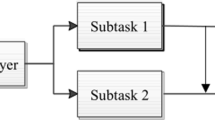Abstract
In this work, we investigate the use of deep learning for distortion-generic blind image quality assessment. We report on different design choices, ranging from the use of features extracted from pre-trained convolutional neural networks (CNNs) as a generic image description, to the use of features extracted from a CNN fine-tuned for the image quality task. Our best proposal, named DeepBIQ, estimates the image quality by average-pooling the scores predicted on multiple subregions of the original image. Experimental results on the LIVE In the Wild Image Quality Challenge Database show that DeepBIQ outperforms the state-of-the-art methods compared, having a linear correlation coefficient with human subjective scores of almost 0.91. These results are further confirmed also on four benchmark databases of synthetically distorted images: LIVE, CSIQ, TID2008, and TID2013.

Similar content being viewed by others
References
Alaei, A., Raveaux, R., Conte, D.: Image quality assessment based on regions of interest. Signal Image Video Process. 11(4), 673–680 (2017)
Allen, E., Triantaphillidou, S., Jacobson, R.: Image quality comparison between jpeg and jpeg2000. I. Psychophysical investigation. J. Imaging Sci. Technol. 51(3), 248–258 (2007)
Bengio, Y.: Deep learning of representations for unsupervised and transfer learning. In: Unsupervised and Transfer Learning Challenges in Mach. Learn. vol. 7, p. 19 (2012)
Bianco, S., Ciocca, G., Marini, F., Schettini, R.: Image quality assessment by preprocessing and full reference model combination. In: IS&T/SPIE Electronic Imaging, pp. 72,420O (2009)
Bovik, A.C.: Automatic prediction of perceptual image and video quality. Proc. IEEE 101(9), 2008–2024 (2013)
Ciancio, A., Da Costa, A.L.N.T., da Silva, E.A., Said, A., Samadani, R., Obrador, P.: No-reference blur assessment of digital pictures based on multifeature classifiers. IEEE Trans. Image Process. 20(1), 64–75 (2011)
Ciocca, G., Corchs, S., Gasparini, F., Schettini, R.: How to assess image quality within a workflow chain: an overview. Int. J. Digit. Libr. 15(1), 1–25 (2014)
Corchs, S., Gasparini, F., Schettini, R.: No reference image quality classification for jpeg-distorted images. Digit. Signal Process. 30, 86–100 (2014)
Eckert, M.P., Bradley, A.P.: Perceptual quality metrics applied to still image compression. Signal Process. 70(3), 177–200 (1998)
Fan, R.E., Chang, K.W., Hsieh, C.J., Wang, X.R., Lin, C.J.: Liblinear: a library for large linear classification. J. Mach. Learn. Res. 9, 1871–1874 (2008)
Ghadiyaram, D., Bovik, A.C.: Blind image quality assessment on real distorted images using deep belief nets. In: Global Conference on Signal and Information Processing (GlobalSIP), pp. 946–950. IEEE (2014)
Ghadiyaram, D., Bovik, A.C.: Crowdsourced study of subjective image quality. In: Asilomar Conference on Signals, Systems and Computers (2014)
Ghadiyaram, D., Bovik, A.C.: Massive online crowdsourced study of subjective and objective picture quality. IEEE Trans. Image Process. 25(1), 372–387 (2016)
He, L., Gao, X., Lu, W., Li, X., Tao, D.: Image quality assessment based on S-CIELAB model. Signal Image Video Process. 5(3), 283–290 (2011)
Hou, W., Gao, X., Tao, D., Li, X.: Blind image quality assessment via deep learning. IEEE Trans. Neural Netw Learn. Syst. 26(6), 1275–1286 (2015)
Huang, Y.M., Du, S.X.: Weighted support vector machine for classification with uneven training class sizes. In: 2005 International Conference on Mach. Learn. and Cybernetics, vol. 7, pp. 4365–4369. IEEE (2005)
Jia, Y., et al.: Caffe: convolutional architecture for fast feature embedding. In: ACM MM, pp. 675–678. ACM (2014)
Kang, L., Ye, P., Li, Y., Doermann, D.: Convolutional neural networks for no-reference image quality assessment. In: CVPR, pp. 1733–1740 (2014)
Kang, L., Ye, P., Li, Y., Doermann, D.: Simultaneous estimation of image quality and distortion via multi-task convolutional neural networks. In: ICIP, pp. 2791–2795. IEEE (2015)
Kottayil, N.K., Cheng, I., Dufaux, F., Basu, A.: A color intensity invariant low-level feature optimization framework for image quality assessment. Signal Image Video Process. 10(6), 1169–1176 (2016)
Krizhevsky, A., Sutskever, I., Hinton, G.E.: Imagenet classification with deep convolutional neural networks. In: NIPS, pp. 1097–1105 (2012)
Larson, E.C., Chandler, D.M.: Most apparent distortion: full-reference image quality assessment and the role of strategy. JEI 19(1), 011,006 (2010)
LeCun, Y., Bengio, Y., Hinton, G.: Deep learning. Nature 521(7553), 436–444 (2015)
LeCun, Y.A., Bottou, L., Orr, G.B., Müller, K-R.: Efficient Back Prop. In: Montavon, G., Orr, G.B., Müller, K-R. (eds) Neural Networks: Tricks of the Trade, 2nd edn, pp. 9–48, Springer, Berlin, Heidelberg (2012)
Li, J., Yan, J., Deng, D., Shi, W., Deng, S.: No-reference image quality assessment based on hybrid model. Signal Image Video Process. 11(6), 985–992 (2017)
Li, J., Zou, L., Yan, J., Deng, D., Qu, T., Xie, G.: No-reference image quality assessment using Prewitt magnitude based on convolutional neural networks. Signal Image Video Process. 10(4), 609–616 (2016)
Lv, Y., Jiang, G., Yu, M., Xu, H., Shao, F., Liu, S.: Difference of Gaussian statistical features based blind image quality assessment: a deep learning approach. In: ICIP, pp. 2344–2348. IEEE (2015)
Mahmoudpour, S., Kim, M.: No-reference image quality assessment in complex-shearlet domain. Signal Image Video Process. 10(8), 1465–1472 (2016)
Manap, R.A., Shao, L.: Non-distortion-specific no-reference image quality assessment: a survey. Inf. Sci. 301, 141–160 (2015)
Mittal, A., Moorthy, A.K., Bovik, A.C.: No-reference image quality assessment in the spatial domain. IEEE Trans Image Process. 21(12), 4695–4708 (2012)
Mittal, A., Soundararajan, R., Bovik, A.C.: Making a completely blind image quality analyzer. SPL 20(3), 209–212 (2013)
Mittal, A., Moorthy, A.K., Bovik, A.C., Chen, C.W., Chatzimisios, P., Dagiuklas, T., Atzori, L.: No-reference approaches to image and video quality assessment. In: Multimedia Quality of Experience (QoE): Current Status and Future Requirements, vol. 99. Wiley (2015)
Moorthy, A.K., Bovik, A.C.: Blind image quality assessment: from natural scene statistics to perceptual quality. IEEE Trans Image Process. 20(12), 3350–3364 (2011)
Pappas, T.N., Safranek, R.J., Chen, J.: Perceptual criteria for image quality evaluation. In: Handbook of Image and Video Processing, pp. 669–684 (2000)
Ponomarenko, N., Ieremeiev, O., Lukin, V., Egiazarian, K., Jin, L., Astola, J., Vozel, B., Chehdi, K., Carli, M., Battisti, F., et al.: Color image database tid2013: peculiarities and preliminary results. In: Visual Information Processing (EUVIP), 2013 4th European Workshop on, pp. 106–111. IEEE (2013)
Ponomarenko, N., et al.: Tid 2008-a database for evaluation of full-reference visual quality assessment metrics. Adv. Mod. Radioelectron. 10(4), 30–45 (2009)
Razavian, A., Azizpour, H., Sullivan, J., Carlsson, S.: CNN features off-the-shelf: an astounding baseline for recognition. In: CVPR Workshops, pp. 806–813 (2014)
Russakovsky, O., Deng, J., Su, H., Krause, J., Satheesh, S., Ma, S., Huang, Z., Karpathy, A., Khosla, A., Bernstein, M., Berg, A.C., Fei-Fei, L.: Imagenet Large Scale Visual Recognition Challenge. Int J Comput Vis. 115(3), 211–252 (2015)
Saad, M.A., Bovik, A.C., Charrier, C.: Blind image quality assessment: a natural scene statistics approach in the DCT domain. Trans. Image Process. 21(8), 3339–3352 (2012)
Seshadrinathan, K., Bovik, A.C.: Automatic prediction of perceptual quality of multimedia signals—a survey. Multimed. Tools Appl. 51(1), 163–186 (2011)
Sheikh, H.R., Wang, Z., Cormack, L., Bovik, A.C.: Live image quality assessment database release 2 (2005). http://live.ece.utexas.edu/research/quality/subjective.htm. Accessed 29 Aug 2017
Simonyan, K., Zisserman, A.: Very deep convolutional networks for large-scale image recognition. arXiv:1409.1556 (2014)
Soundararajan, R., Bovik, A.C.: Survey of information theory in visual quality assessment. Signal Image Video Process. 7(3), 391–401 (2013)
Szegedy, C., et al.: Going deeper with convolutions. In: IEEE CVPR, pp. 1–9 (2015)
Tang, H., Joshi, N., Kapoor, A.: Blind image quality assessment using semi-supervised rectifier networks. In: CVPR, pp. 2877–2884 (2014)
Triantaphillidou, S., Allen, E., Jacobson, R.: Image quality comparison between jpeg and jpeg2000. II. Scene dependency, scene analysis, and classification. J. Imaging Sci. Technol. 51(3), 259–270 (2007)
Vu, C.T., Phan, T.D., Chandler, D.M.: S3: a spectral and spatial measure of local perceived sharpness in natural images. Trans. Image Process. 21(3), 934–945 (2012)
Wang, Z., Bovik, A.C., Sheikh, H.R., Simoncelli, E.P.: Image quality assessment: from error visibility to structural similarity. IEEE Trans. Image Process. 13(4), 600–612 (2004)
Xu, J., Ye, P., Li, Q., Du, H., Liu, Y., Doermann, D.: Blind image quality assessment based on high order statistics aggregation. IEEE Trans. Image Process. 25(9), 4444–4457 (2016)
Ye, P., Kumar, J., Kang, L., Doermann, D.: Real-time no-reference image quality assessment based on filter learning. In: CVPR, pp. 987–994 (2013)
Zhang, Y., Moorthy, A.K., Chandler, D.M., Bovik, A.C.: C-DIIVINE: no-reference image quality assessment based on local magnitude and phase statistics of natural scenes. Signal Process. Image Commun. 29(7), 725–747 (2014)
Zhou, Z.H., Liu, X.Y.: Training cost-sensitive neural networks with methods addressing the class imbalance problem. Trans. Knowl. Data Eng. 18(1), 63–77 (2006)
Author information
Authors and Affiliations
Corresponding author
Rights and permissions
About this article
Cite this article
Bianco, S., Celona, L., Napoletano, P. et al. On the use of deep learning for blind image quality assessment. SIViP 12, 355–362 (2018). https://doi.org/10.1007/s11760-017-1166-8
Received:
Revised:
Accepted:
Published:
Issue Date:
DOI: https://doi.org/10.1007/s11760-017-1166-8




